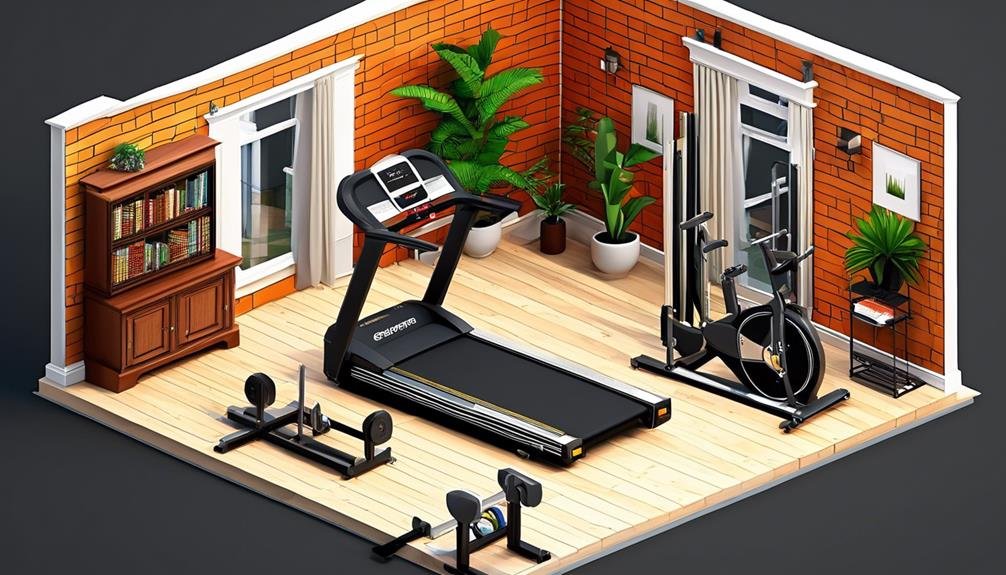Coincidentally stumbling upon a pair of gymnastic rings can be both exciting and intimidating. You might find yourself wondering how to safely incorporate these versatile tools into your strength training routine.
Well, fear not, as this discussion will guide you through the process of using gymnastic rings in a way that maximizes your gains while minimizing the risk of injury.
So, if you’re ready to take your strength training to new heights, let’s dive into the world of gymnastic rings and discover the secrets to using them safely and effectively.
Key Takeaways
- Choose and set up reliable and secure gymnastic rings with the right size and material for your needs and goals.
- Warm up before using the rings, including dynamic movements and static stretches, to increase flexibility and prevent injury.
- Master basic ring exercises such as pull-ups, dips, push-ups, and rows with proper form and technique.
- Progress gradually to advanced ring movements like muscle-ups, front levers, and iron crosses, prioritizing safety and proper technique.
Choosing the Right Gymnastic Rings
When selecting gymnastic rings for strength training, it’s essential to carefully consider the right type of rings that will suit your specific needs and goals. There are a few key factors to consider when choosing the right gymnastic rings for your training.
First, you should consider the material of the rings. Wooden rings are a popular choice due to their superior grip and comfort compared to plastic or metal rings. Additionally, wooden rings are more durable and can withstand the demands of intense workouts.
Another factor to consider is the size of the rings. It’s important to choose rings that are the right diameter for your hands to ensure a comfortable and secure grip. The thickness of the rings should also be taken into account, as thicker rings provide a more challenging workout for your grip strength.
Lastly, make sure to choose rings that have a reliable and secure locking mechanism to ensure your safety during training.
Setting Up the Rings Properly
To properly set up the gymnastic rings, ensure that you have a sturdy and secure anchor point for suspension. This is crucial to ensure your safety during your strength training sessions. Here are some key points to keep in mind when setting up your gymnastic rings:
| Key Points | Description |
|---|---|
| Anchor Point | Choose a sturdy and secure anchor point, such as a ceiling beam or a pull-up bar, that can support your body weight. Make sure it is able to handle the maximum load capacity of the rings. |
| Height | Adjust the height of the rings according to your comfort level and the exercises you plan to perform. For beginners, it is recommended to start with the rings at chest height. |
| Distance | Position the rings at a distance that allows you to fully extend your arms without touching the ground when hanging from the rings. This will ensure proper form and prevent any injury. |
| Stability | Make sure the rings are stable and do not wobble or swing excessively. Use straps or carabiners to securely attach the rings to the anchor point and check for any signs of wear or damage before each use. |
Following these guidelines will help you set up your gymnastic rings properly and ensure a safe and effective strength training session. Remember to always prioritize your safety and take the time to inspect your equipment before each use.
Warming Up and Stretching

Now that you have properly set up your gymnastic rings, it’s important to focus on warming up and stretching before starting your strength training session.
Warming up prepares your body for the physical demands of exercise and helps prevent injuries. It increases blood flow to your muscles, raises your body temperature, and improves your flexibility. A good warm-up should include dynamic movements that target the muscles you’ll be using during your workout. For example, you can start with arm swings, leg swings, and trunk rotations.
Stretching is equally important as it helps improve your range of motion and flexibility, reducing the risk of muscle strains and tears. It’s recommended to perform static stretches after your warm-up or at the end of your workout. Hold each stretch for 15 to 30 seconds, focusing on the major muscle groups involved in your training. Remember to breathe deeply and relax into each stretch.
Mastering the Basic Ring Exercises
To master the basic ring exercises, focus on proper form and technique to maximize your strength and control.
Start with the most fundamental exercise – the ring pull-up. Grab the rings with an overhand grip, hands slightly wider than shoulder-width apart. Engage your core and pull your chest up towards the rings, keeping your elbows close to your body. Lower yourself back down with control.
As you progress, try the ring dip exercise. Hold onto the rings with a neutral grip, keeping your elbows tucked in. Lower yourself down until your upper arms are parallel to the ground, then push back up.
To work on your stability and balance, attempt the ring push-up. Assume a push-up position with your hands on the rings. Lower your chest towards the rings while maintaining a straight body line, then push back up.
Lastly, challenge yourself with the ring row. Set the rings to a height where you can hang underneath them. Keep your body straight and pull your chest up towards the rings, squeezing your shoulder blades together.
Progressing to Advanced Ring Movements

As you progress in your strength training journey, you can challenge yourself by advancing to more complex ring movements.
Once you have mastered the basic ring exercises, it’s time to take your training to the next level. Advanced ring movements require a higher level of strength, stability, and coordination.
One popular advanced movement is the muscle-up, which combines a pull-up with a dip. To perform a muscle-up, start with a false grip on the rings and pull yourself up until your chest reaches the rings. From there, transition into a dip by pushing yourself up and over the rings.
Another advanced movement is the front lever, which involves holding your body parallel to the ground while hanging from the rings. To achieve a front lever, engage your core, pull your shoulder blades down, and keep your body straight. Gradually increase your hold time as you become stronger.
Finally, the iron cross is an advanced movement that showcases immense upper body strength. It involves holding your body horizontally while fully extending your arms out to the sides. This movement requires significant time and practice to achieve safely.
Remember to always prioritize proper form and technique when attempting advanced ring movements to prevent injury and maximize results.
Avoiding Common Mistakes and Injuries
To maintain proper form and prevent injuries while performing advanced ring movements, it’s crucial to be aware of and avoid common mistakes. Here are three key points to keep in mind:
- Grip Strength:
- One common mistake is neglecting to develop proper grip strength.
- When using gymnastic rings, your grip plays a vital role in maintaining control and stability.
- To avoid injuries, focus on strengthening your grip through exercises such as dead hangs, towel pull-ups, and farmer’s carries.
- This will help you maintain a secure hold on the rings and reduce the risk of slipping or losing control.
- Core Stability:
- Another mistake is failing to engage your core muscles properly.
- Your core acts as a stabilizer during ring movements, and without proper engagement, you may experience lower back pain or strain.
- To avoid this, focus on strengthening your core through exercises like planks, hollow holds, and Russian twists.
- Building a strong core will provide the stability necessary for safe and effective ring training.
- Progression:
- Lastly, rushing into advanced ring movements without proper progression can lead to injuries.
- It’s essential to start with basic exercises and gradually increase the difficulty over time.
- This allows your body to adapt and build the necessary strength and stability.
- Rushing the process increases the risk of overexertion and strain on your muscles and joints.
Incorporating Rings Into Your Strength Training Routine
Incorporate gymnastic rings into your strength training routine to enhance your overall athleticism and build functional strength.
Rings offer a unique challenge as they require you to stabilize your body while performing various exercises. Start by incorporating them into your upper body workouts.
Ring rows are a great exercise to develop your back and biceps. Adjust the height of the rings to your skill level and gradually increase the difficulty as you progress.
Another effective exercise is the ring push-up, which targets your chest, shoulders, and triceps. Remember to keep your body in a straight line and engage your core for stability.
For lower body strength, you can perform pistol squats using the rings for support. This exercise targets your quads, glutes, and hamstrings.
Finally, don’t forget about core training. Ring planks and ring roll-outs are excellent for developing core stability and strength.
Incorporating gymnastic rings into your strength training routine won’t only increase your strength but also improve your balance, coordination, and overall athletic performance.
Start slowly, focus on proper form, and gradually progress to more challenging exercises.
Frequently Asked Questions
How Long Should I Rest Between Sets When Using Gymnastic Rings for Strength Training?
Resting between sets when using gymnastic rings for strength training depends on your fitness level and the intensity of your workout. As a general guideline, aim for 1-2 minutes of rest to allow your muscles to recover and perform at their best.
Can I Use Gymnastic Rings if I Have a Shoulder Injury?
Yes, you can use gymnastic rings even with a shoulder injury. However, it’s important to consult with a medical professional and modify exercises to avoid exacerbating the injury. Safety first!
What Is the Recommended Frequency for Incorporating Gymnastic Rings Into My Strength Training Routine?
To safely incorporate gymnastic rings into your strength training routine, it’s recommended to start with 2-3 sessions per week. Gradually increase the frequency as you become comfortable and progress in your training. Listen to your body and give yourself rest days to avoid overtraining.
How Do I Properly Grip the Gymnastic Rings to Avoid Hand Injuries?
To avoid hand injuries when gripping gymnastic rings, make sure to wrap your fingers securely around the rings, keeping your wrists straight and your grip firm. This will provide stability and reduce the risk of accidents.
Are There Any Specific Exercises I Should Avoid When Using Gymnastic Rings for Strength Training?
You should avoid exercises that exceed your current strength and skill level, as well as those that put excessive strain on your joints. It’s important to progress gradually and listen to your body to prevent injuries.
Conclusion
To safely use gymnastic rings for strength training, it’s crucial to:
- Choose the right rings
- Set them up properly
- Warm up and stretch beforehand
Master the basic exercises before progressing to advanced movements.
By avoiding common mistakes and injuries and incorporating rings into your strength training routine, you can effectively build strength and achieve your fitness goals.
Remember to always prioritize safety and consult with a professional if needed.





